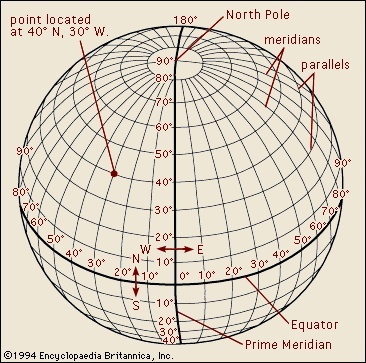latitude and longitude
geography
 coordinate system by means of which the position or location of any place on the Earth's surface can be determined and described.
coordinate system by means of which the position or location of any place on the Earth's surface can be determined and described.
 Latitude is a measurement on a globe or map of location north or south of the Equator. Technically there are different kinds of latitude—geographic, astronomical, and geocentric—but there are only minor differences between them. In most common references, geographic latitude (the kind used in mapping) is implied. Given in degrees, minutes, and seconds, geographic latitude is the arc subtended by an angle at the centre of the Earth and measured in a north-south plane poleward from the Equator. Thus, a point at 30°15′20″ N subtends an angle of 30°15′20″at the centre of the globe; similarly, the arc between the Equator and either geographic pole is 90° (one-fourth the circumference of the Earth, or 1/4 × 360°), and thus the greatest possible latitudes are 90° N and 90° S. As aids to indicate different latitudinal positions on maps or globes, equidistant circles are plotted and drawn parallel to the Equator and each other; they are known as parallels (parallel), or parallels of latitude.
Latitude is a measurement on a globe or map of location north or south of the Equator. Technically there are different kinds of latitude—geographic, astronomical, and geocentric—but there are only minor differences between them. In most common references, geographic latitude (the kind used in mapping) is implied. Given in degrees, minutes, and seconds, geographic latitude is the arc subtended by an angle at the centre of the Earth and measured in a north-south plane poleward from the Equator. Thus, a point at 30°15′20″ N subtends an angle of 30°15′20″at the centre of the globe; similarly, the arc between the Equator and either geographic pole is 90° (one-fourth the circumference of the Earth, or 1/4 × 360°), and thus the greatest possible latitudes are 90° N and 90° S. As aids to indicate different latitudinal positions on maps or globes, equidistant circles are plotted and drawn parallel to the Equator and each other; they are known as parallels (parallel), or parallels of latitude.Different methods are used to determine geographic latitude, as by taking angle-sights on certain polar stars or by measuring with a sextant the angle of the noon Sun above the horizon. The length of a degree of arc of latitude is approximately 111 km (69 miles), varying, because of the nonuniformity of the Earth's curvature, from 110.567 km (68.706 miles) at the Equator to 111.699 km (69.41 miles) at the poles.
 Longitude is a measurement of location east or west of the prime meridian at Greenwich (Greenwich meridian), the specially designated imaginary north-south line that passes through both geographic poles and Greenwich, London. Measured also in degrees, minutes, and seconds, longitude is the amount of arc created by drawing first a line from the centre of the Earth to the intersection of the Equator and the prime meridian and then another line from the centre of the Earth to any point elsewhere on the Equator. Longitude is measured 180° both east and west of the prime meridian. As aids to locate longitudinal positions on a globe or map, meridians are plotted and drawn from pole to pole where they meet. The distance per degree of longitude at the Equator is about 111.32 km (69.18 miles) and at the poles, 0.
Longitude is a measurement of location east or west of the prime meridian at Greenwich (Greenwich meridian), the specially designated imaginary north-south line that passes through both geographic poles and Greenwich, London. Measured also in degrees, minutes, and seconds, longitude is the amount of arc created by drawing first a line from the centre of the Earth to the intersection of the Equator and the prime meridian and then another line from the centre of the Earth to any point elsewhere on the Equator. Longitude is measured 180° both east and west of the prime meridian. As aids to locate longitudinal positions on a globe or map, meridians are plotted and drawn from pole to pole where they meet. The distance per degree of longitude at the Equator is about 111.32 km (69.18 miles) and at the poles, 0. The combination of meridians of longitude and parallels of latitude establishes a framework or grid by means of which exact positions can be determined in reference to the prime meridian and the Equator: a point described as 40° N, 30° W, for example, is located 40° of arc north of the Equator and 30° of arc west of the Greenwich meridian.
The combination of meridians of longitude and parallels of latitude establishes a framework or grid by means of which exact positions can be determined in reference to the prime meridian and the Equator: a point described as 40° N, 30° W, for example, is located 40° of arc north of the Equator and 30° of arc west of the Greenwich meridian.- Satyendra Prassano Sinha, 1st Baron Sinha of Raipur
- Satyr and Silenus
- satyr butterfly
- Satyricon
- satyr play
- Satō Eisaku
- Satō Haruo
- Satō Nobuhiro
- Saubel, Katherine Siva
- sauce
- sauceboat
- Saucesian Stage
- Sauckel, Fritz
- saudade
- Saudi Arabia
- Saudi Arabia, flag of
- sauerbraten
- Sauer, Carl O
- Sauer, Emil von
- sauerkraut
- Sauerland
- Sauganash
- sauger
- Sauguet, Henri
- Saugus